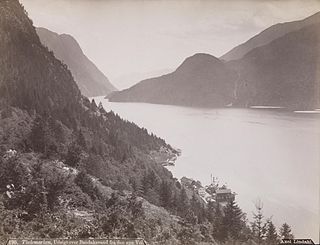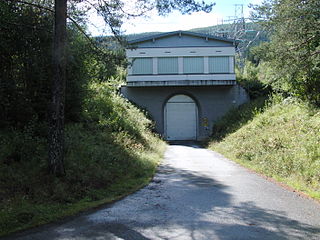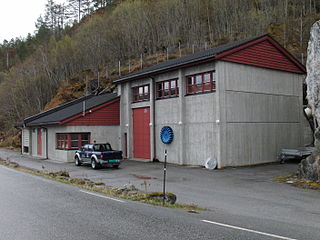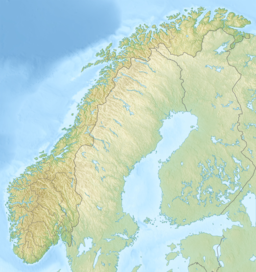
Tisleifjorden is a lake on the border of Innlandet and Buskerud counties in Norway. The lake lies in Nord-Aurdal municipality in Innlandet county, as well in Gol and Hemsedal municipalities in Buskerud county. Tisleifjorden is dammed for hydroelectric power. The height of the lake sits around 819 metres (2,687 ft) above sea level, but it can vary up to 11 metres (36 ft). The 13.54-square-kilometre (5.23 sq mi) lake has a circumference of about 32.5 kilometres (20.2 mi). It is located about 25 kilometres (16 mi) to the southwest of the town of Fagernes.

Vasslivatnet is a lake in the municipality of Heim in Trøndelag county, Norway. The 2.92-square-kilometre (1.13 sq mi) lake lies along European route E39, about 13 kilometres (8.1 mi) east of the village of Vinjeøra. The lake is a man-made lake along the river Søo. There is a dam on the west end that is part of a hydropower plant.

Bandak is a lake in the municipalities of Kviteseid and Tokke in Telemark county, Norway. The lake, which is part of the Telemark Canal route, belongs to the Skien watershed. The river Tokke flows into the lake, and the outlet is via the river Strauman, which flows to the lake Kviteseidvatn.
Blådalsvatnet is a glacial lake in the municipality of Kvinnherad in Vestland county, Norway. The 2.89-square-kilometre (1.12 sq mi) lake lies just outside the Folgefonna National Park, about 10 kilometres (6.2 mi) north of the village of Indre Matre. The lake is formed by the glacial runoff from the large Folgefonna glacier located just north of the lake. The lake is part of the water system used to power the Blåfalli kraftverk hydroelectric power station.
Stolsvatnet is a regulated lake in the municipalities of Ål and Hol in Buskerud, Norway. Stolsvatnet was formed in the late 1940s by the damming of the upper parts of three rivers, which created a continuous lake across the watersheds. The new lake covered a number of existing smaller lakes. It is a reservoir for Hol I kraftverk, a hydroelectric power plant located off FV 50 by Hovet in Hol. The power plant is owned and operated by E-Co Energi.

Vavatn is a lake in the municipality of Hemsedal in Buskerud county, Norway. It is a water source for Gjuva kraftverk, a hydro-electric power plant, which utilizes the waterfall from the lake into the Gjuva river as it enters the valley of Grøndalen. The power station was put into operation in 1957 but was rehabilitated in 1995. The owner-operator is E- CO Energi.
Ørteren is a lake in the municipality of Hol in Buskerud county, Norway.

Rødungen is a lake in Buskerud County, Norway. The lake is located on the border between the municipalities of Ål and Nore og Uvdal. Waterfall from the lake is a power source for Usta kraftverk, a hydro-electric plant. The power station exploits the fall of the Usta River from Rødungen as well as Ustevatn. The plant started production in 1965 and is owned and operated by E- CO Energi.
Falningsjøen is a lake in Tynset Municipality in Innlandet county, Norway. The lake lies about 4.5 kilometres (2.8 mi) northeast of the village of Yset. The Ya River begins at this lake. The Forollhogna National Park boundary lies at the north end of the lake.

Usta or Usteåne is a river located in the municipality of Hol in Buskerud, Norway. It flows from Lake Ustevatn traveling northeast down the valley of Ustedalen to its confluence with Holselva. The ski resort at Geilo is situated just north of the river, about halfway down Ustedalen valley. The valley stretches about 20 kilometres (12 mi) east from Ustevatn and meetings Holsdalføret below Hagafoss.

Glomfjord power plant is a hydroelectric power plant in the village of Glomfjord in the municipality of Meløy in Nordland county, Norway. It gets its water from Nedre Navervatn lake which is located about 465 metres (1,526 ft) above sea level. The plant also house a newer 2.4MW Francis generator taking water from Fykanvatn lake as well. The outlet of the plant is the Glomfjorden and then the Norwegian Sea.

Pålsbufjorden is a lake in the municipalities of Hol and Nore og Uvdal, both in Buskerud County, Norway. The water table lies 749 meters above sea level. The area of the lake is 19.55 square kilometres (7.55 sq mi). The Pålsbu kraftverk hydro-electric plant was built to extract power from the water that draining from Pålsbufjorden down into Tunhovdfjorden. The power plant, which went into operation during 2007, is designed as a turbine from above and is built in concrete. It is located just below Pålsbufjorden dam. Pålsbufjorden and Tunhovdfjorden are both part of the Numedalslågen watershed.

The Cårrujavrit Hydroelectric Power Station is a hydroelectric power station in the municipality of Kvænangen in Troms county, Norway. It utilizes a drop of 305 meters (1,001 ft) between its intake reservoir on the Njemenaiko River and Little Lakes, which is also the reservoir for the Kvænangsbotn Hydroelectric Power Station. Lake Tjoika serves as the reservoir for the plant and is regulated at a level between 529 m (1,736 ft) and 516 m (1,693 ft). The plant has a Francis turbine and operates at an installed capacity of 1.7 MW, with an average annual production of about 11 GWh. The plant is controlled by Kvænangen Kraftverk AS, with a 48.2% share owned by Troms Kraft.

The Kvænangsbotn Hydroelectric Power Station is a hydroelectric power station in the municipality of Kvænangen in Troms county, Norway. It utilizes a drop of 305 meters (1,001 ft) between its intake reservoir at Little Lakes and South Fjord. The reservoir is regulated at a level between 315 m (1,033 ft) and 305 m (1,001 ft). The Abo River is also utilized by the power plant. Water is supplied to the reservoir by the Småvatna, Lassajavre, and Cårrujavrit Hydroelectric Power Stations. The plant came into operation in 1965. In 1999 the company received a license to transfer water from the Brenn River, Šleađui River, and Olbmá River. The plant has a Francis turbine and operates at an installed capacity of 44 MW, with an average annual production of about 176 GWh. The plant is controlled by Kvænangen Kraftverk AS, with a 48.2% share owned by Troms Kraft.

The Lassajavre Hydroelectric Power Station is a hydroelectric power station in the municipality of Kvænangen in Troms county, Norway. The plant utilizes a drop between Lake Abo and Lake Lassa. Lake Abo is regulated at a level between 689 meters (2,260 ft) and 669 m (2,195 ft), and Lake Lassa serves as the reservoir for the Småvatna Hydroelectric Power Station. The Lassajavre plant also utilizes water from Lake Mollis and Lake Sarves. The plant came into operation in 1977. It has a Francis turbine and operates at an installed capacity of 7.2 MW, with an average annual production of about 30 GWh. The plant is controlled by Kvænangen Kraftverk AS, with a 48.2% share owned by Troms Kraft.

The Småvatna Hydroelectric Power Station is a hydroelectric power station in the municipality of Kvænangen in Troms county, Norway. The plant utilizes a 283-meter (928 ft) drop between Lake Lassa and Little Lakes. Lake Lassa is regulated at a level between 543 m (1,781 ft) and 519 m (1,703 ft), and Little Lakes serves as the reservoir for the Kvænangsbotn Hydroelectric Power Station. The Småvatna plant also utilizes water from Abo River and the Lassajavre Hydroelectric Power Station. The plant came into operation in 1969. It has a Francis turbine and operates at an installed capacity of 18.8 MW, with an average annual production of about 61 GWh. The plant is controlled by Kvænangen Kraftverk AS, with a 48.2% share owned by Troms Kraft.

The Sundsfjord Hydroelectric Power Station is a hydroelectric power station in the municipality of Gildeskål in Nordland county, Norway. Part of the plant's catchment area also lies in the municipality of Beiarn.

The Grytdalen Hydroelectric Power Station is a hydroelectric power station in Valsøyfjord in the municipality of Heim in Trøndelag county, Norway. It stands about 1.8 kilometers (1.1 mi) south of the village of Engan. It is a run-of-river plant that utilizes a 50-meter (160 ft) drop from the lake Englivatnet to the intake dam of the Valsøyfjord Hydroelectric Power Station. It has a Francis turbine and operates at an installed capacity of 1.3 MW, with an average annual production of about 5.3 GWh. The plant came into operation in March 2012 and is owned by Svorka Energi.

The Valsøyfjord Hydroelectric Power Station is a hydroelectric power station in Valsøyfjord in the municipality of Heim in Trøndelag county, Norway. It stands downstream from the Grytdalen Hydroelectric Power Station and is a run-of-river plant that utilizes a 187-meter (614 ft) drop on the Grytåa River. The river flows from the lake Englivatnet, which is regulated between 243 meters (797 ft) and 235 meters (771 ft), to Valsøyfjord. The plant has an average annual production of about 17 GWh. The new plant came into operation in 1994, and is owned by Svorka Energi.















